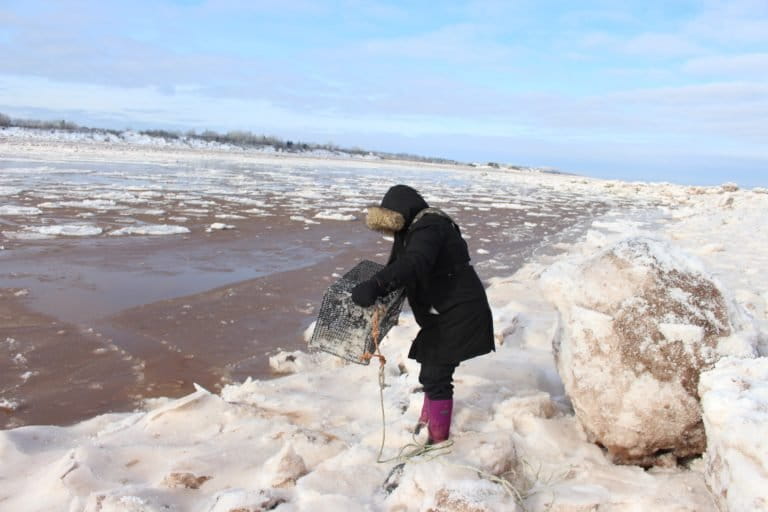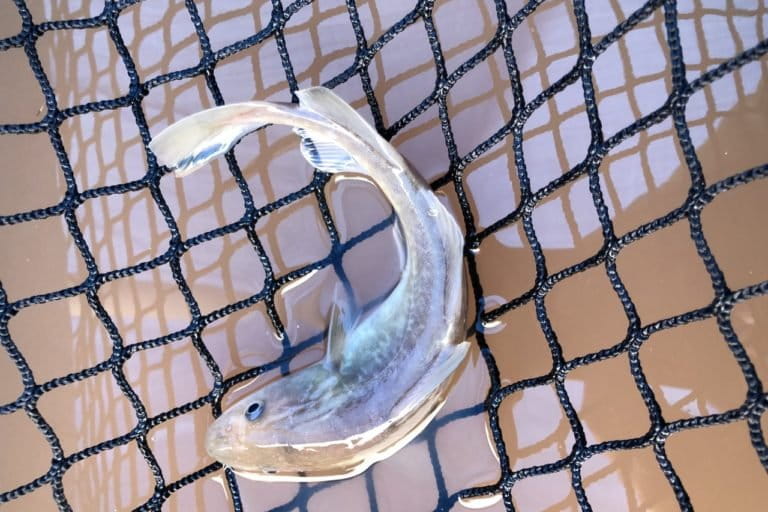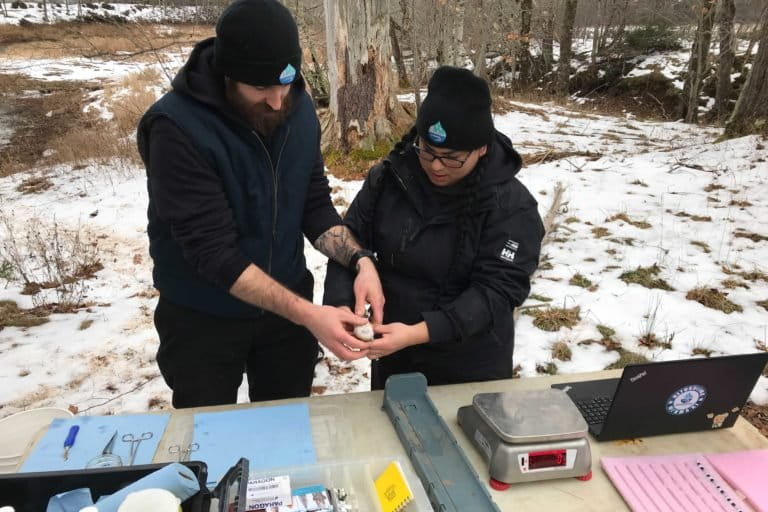- The Apoqnmatulti’k project combines Indigenous knowledge, Western science and local knowledge holders to gather information about three important marine species in two ecosystems in Nova Scotia, Canada.
- The project comes at a time of increased urgency over management of marine species, as many fish stocks are on the decline, while access to lucrative fisheries has sparked conflict.
- Project partners say the project’s collaborative approach will provide information that could help direct stewardship and conservation of species that are important to many communities.
- As important as that new data is, project participants say the greatest insight of the project may be that forging the trusting relationships required for collaborative research takes time, which doesn’t always correspond to standard academic deadlines.
COLCHESTER COUNTY, Canada — Standing on the snow-covered banks of the Shubenacadie River in Canada’s eastern province, Nova Scotia, Alanna Sylbiloy tosses a wire trap into the icy water flowing past, in search of a small fish known as a tomcod.
Atlantic tomcod (Microgadus tomcod) — or punamu in the language of the Mi’kmaq, the Indigenous people of the region — are an unassuming fish. They’re an indifferent swimmer, 15 centimeters (6 inches) long at most, and sometimes white, appropriate for a species also called “frostfish” because they travel upriver to spawn in January. They’re also sometimes the same mottled brown as the blocks of ice Syliboy points to on the banks of the river that ebbs and flows to the rhythm of the world’s highest tides in the nearby Bay of Fundy.

But the species is significant in one way, Syliboy tells Mongabay. “This fish is a historical fish for our people. It kept us alive for thousands of years; they are the staple fish and they come right up to our river.”
After half an hour, Syliboy braces herself against the bank and begins hauling the trap out of the water. If there are fish inside, she’ll perform a quick surgery to implant a tag, which will allow the fish to be tracked with acoustic receivers placed throughout this watershed. This will allow her to better assess the tomcod’s movements and spawning habitats.
It’s part of a project called Apoqnmatulti’k that combines Indigenous and Western knowledge, as well as insights from local fishers, to better understand the movements of lobster, eel and tomcod in two important ecosystems. The project is moving into the final year of its original three-year timeline. In the case of the tomcod, Syliboy says Indigenous community members wanted to know whether they were spawning in the river and if they remained there all year. Traditional knowledge can provide answers to some of these questions, says Syliboy, who is also the community liaison with the Apoqnmatulti’k project.
“But we need change, to use science to back that up. So they’re complementing and strengthening each other,” she says.
In working this way, the project has forged what participants describe as a new process of bringing together worldviews that haven’t always been in sync. The idea is that this could in turn inform decisions about how to manage marine species for the benefit of ecosystems and the communities who depend on them.

“I hope that it will help everyone understand that at the end of the day, we all live here, and we all depend on each other and this world,” Syliboy says. “If this project can teach anybody anything, it’s that even despite the differences of knowledge and understanding, you can still work together for the same benefit.”
A sense of urgency for collaboration and research
The state of marine species is an important consideration in Nova Scotia, where many Indigenous and coastal communities depend on fisheries. American lobster, for instance, forms the basis of the region’s most lucrative fishery, which brings in nearly C$700 million ($550 million) a year. Other fisheries, though smaller, also play an important role in the economic and cultural life of coastal communities.
But historically, decisions about these species haven’t always incorporated local and Indigenous knowledge. Moreover, the question of who is able to benefit from the use of these species has at times been a point of conflict.
In 2020, when a Mi’kmaq community launched a livelihood lobster fishery outside of the commercial season — a fishery to which a 1999 Supreme Court of Canada decision affirmed Indigenous communities have a right — it sparked resistance, at times violent, from non-native commercial fishers, who identified concerns with conservation of the stock.

Mi’kmaq communities have brought a number of court cases against provincial and federal governments for interfering in their self-regulated lobster fishery, on the grounds that such interference violates treaty rights. On the other hand, an association representing stakeholders in the commercial fishery has since been granted intervenor status to participate in the lawsuits, with the goal of keeping regulation of Indigenous fisheries on par with that of commercial fisheries. The association cited a desire to ensure the conservation and sustainability of the fishing industry for future generations. Meanwhile, stocks of other important fish species in the region have dropped to critical levels in recent years, prompting frustration among Indigenous communities and commercial fishers alike.
All of this has contributed to an increased sense of urgency for research that could inform better stewardship of species, and which all communities can trust. The Apoqnmatulti’k project has been working to build some of that trust, by bringing together Western scientists, Indigenous communities and local knowledge holders to monitor the movements and habitats of significant species in two parts of the province.
In the Bay of Fundy, which includes the tidal Shubenacadie River, the project is also tracking the movements of the American eel (Anguilla rostrata), a threatened species. In the saltwater Bras d’Or Lake of Unama’ki/Cape Breton, the northernmost part of Nova Scotia, the project is studying eels and American lobsters (Homarus americanus).

Sara Iverson, a professor of biology at Dalhousie University in Halifax, Nova Scotia, and scientific director of the Ocean Tracking Network, says the project was designed to bring together different ways of knowing, including the Ocean Tracking Network’s expertise in electronic tagging and acoustic monitoring.
But from its inception, Iverson says, the project has also sought to involve Indigenous communities and local fishers in a collaborative principle that’s reflected in the project’s name.
“We asked the [Mi’kmaq] Elder Albert Marshall to help us come up with a name,” Iverson tells Mongabay. “And it’s Apoqnmatulti’k, which means ‘we help each other’ in Mi’kmaq. So it’s been very interesting, in terms of coming together and trying to create a really open dialog.”
Incorporating Indigenous two-eyed seeing
For Shelley Denny, the foundational nature of the partnership is key. Denny is the director of aquatic research and stewardship for the Unama’ki Institute of Natural Resources, an organization that represents the five Mi’kmaq communities of Unama’ki on natural resources issues. The organization is also a partner in the project, which uses the collaborative approach to science known as two-eyed seeing, a term also coined by Albert Marshall. Two-eyed seeing is a framework for combining Indigenous and Western knowledge systems to better understand the natural world.

“It’s more than just the knowledge itself — it’s how we acquire that knowledge,” Denny says. “Two-eyed seeing starts with the whole project: it’s in the research questions, it’s how we interact, it’s how we collect samples.”
Two-eyed seeing, or etuaptmumk, is an influential concept that has been adopted into the policies of institutions across Canada. Along with other philosophies that advocate for a similar approach, it’s also helped fuel a wave of interest in partnering with Indigenous groups on research projects.
But for that partnership to avoid being seen as simply “verifying” Mi’kmaq knowledge using Western science, or applying Indigenous knowledge in a token way, Indigenous partners need to be involved in the decision-making process of the project, Denny says. In the case of the Apoqnmatulti’k project, communities were involved in questions such as the selection the study species.
“We’re always very aware of the power of Western knowledge over Mi’kmaq knowledge and that’s something we struggle with,” Denny says. “So, in this situation, we see that our knowledge is being used to support further scientific inquiry into certain areas — it’s not about proving it, but we want to have another way of looking at it as well.”

In the case of one of the study species, eel, the project is combining traditional knowledge of eel habitat with acoustic tracking to shed light on questions such as the location of the eel’s overwintering grounds, for which there are gaps in current Western scientific knowledge. Eel is an important source of food and medicine for Mi’kmaq communities.
Ultimately, this collaborative approach could be used to advance the communities’ goals, Denny says. This includes identifying eel habitat in areas that are vulnerable to development and would benefit from increased protection.
But according to Denny, as important as that knowledge could be, one of the most significant insights gleaned from this project is in what it’s shown about how knowledge systems long perceived as contradictory can work together.
“This isn’t just about tracking lobster and eel,” she says, “this is about a partnership between two very different ways of thinking.”
Building relationships is just as important
Darren Porter, a commercial fisherman who has also partnered in the project from the beginning, says ensuring that commercial fishers also have a seat at the table is a way of strengthening relationships that have been challenged in recent years: between fishers and scientists, as well as between fishers and Indigenous communities.

“You can’t just leave out the one group and expect them to buy into this,” he says. “If they’re out together, gathering this information together, [and] building relationships, then whoever’s doing that can take that information back to their respective camps, and say, ‘listen, this is what we’ve seen, this is what’s going on.’
“There’s no ulterior motive. It’s just science — pure knowledge. And you can’t argue with it if you’re all involved in it. So, this [collaboration] is the answer to almost all conflicts in the ecosystem.”
At times, Porter says, his role has entailed tapping other project partners on the shoulder to remind them not to forget about the role of local fishers.
This is especially important given that local knowledge holders and Indigenous communities often have the same goal, Porter says: preserving and protecting the environment.
“I’m on the water, and Mi’kmaq knowledge holders are on the water, and we see what’s going on in real time,” Porter says. “When we communicate, we can help keep the academics on point to what’s important in some cases. And they can [also] help us keep things on point.”

The researchers involved in the project say they’ve learned something too, including that combining Indigenous and Western forms of knowledge into a new knowledge system takes time.
“The process of doing the work is just as important as the results that you get, and I think that doesn’t necessarily fit with normal academic timetables,” says Iverson from Dalhousie University.
“That’s where I think we’ve learned the most: that a three-year project is simply not enough time to get the normal scientific results that granting agencies and university programs would expect — and making that clear, that the process of building these relationships is just as important as the scientific output.”
Back on the banks of the Shubenacadie, Alanna Syliboy says she’s brought that principle of relationship building into her own work. She’s learned how to tag fish while working on the project.
In turn, she’s had to advocate at times for more respectful treatment of the study species, including changing tagging practices so that team members stop and make an offering when a fish is accidentally killed during the tagging process, or requesting that if eels have to be killed deliberately, it be done in a way that aligns with Mi’kmaq ethics.
Speaking up about those concerns was intimidating, Syliboy says, but she reminded herself of the name of the project, and its meaning of mutual aid.

“You know, they’re helping us learn the science. But we also have to help them understand the Mi’kmaq worldview — and building those relationships, and foundations, takes time.”
Ultimately there’s a lot at stake in this collaboration, both for the ecosystem and for communities. Even though the tomcod helped sustain Mi’kmaq people for thousands of years, by providing a reliable source of food at a time when little else was available, Syliboy didn’t grow up eating it herself. Her mother and grandparents are survivors of Canada’s residential school system, which caused widespread culture and traditional knowledge loss among Indigenous people in the country.
‘It’s time to reclaim that knowledge,” she says. “That’s what my job and this project allow me to do, because we are working for our communities and our people.”
Eventually, she says she hopes to teach her own children to harvest tomcod, something that the project has already helped by filling in some of the gaps in research.
But in the meantime, after hauling in empty traps, Syliboy gives up tagging at the site. It’s a typical outcome in an unusually difficult year for tagging; a traditional knowledge holder who advises the team on tomcod says he’s never seen a winter like this one. It’s a reminder of the unpredictable shifts that are on the way due to climate change, and the role of collaborative research in helping all communities prepare for the challenges still to come.
Banner image: Team members prepare to deploy an acoustic receiver in the Bras D’or Lake. The receivers are anchored on the bottom of lakes and the ocean floor, and can pick up the signal of a tagged animal that passes within 500 metres. Image courtesy of Nicolas Winkler Photography.
Related audio from Mongabay’s podcast: Ethnobotanist Gary Paul Nabhan and marine biologist Sara Iverson discuss Indigenous traditional ecological knowledge, Western science, and ‘two-eyed seeing,’ listen here:
FEEDBACK: Use this form to send a message to the author of this post. If you want to post a public comment, you can do that at the bottom of the page.













